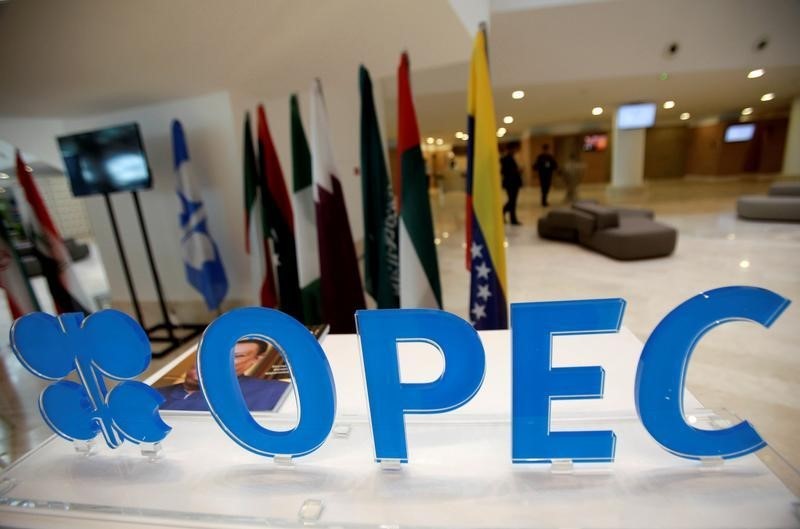Investing.com – With global oil markets closed on Monday and crude prices having pocketed gains of around 50% during 2016, traders prepared to watch developments surrounding the landmark deal reached by the Organization of the Petroleum Exporting Countries (OPEC) and several non-OPEC oil producers to reduce their output this year.
Oil futures finished with modest losses in the final trading session of 2016 on Friday, but scored the biggest annual gain since 2009 in the wake of the agreement to tackle the global supply glut and support crude prices.
OPEC members agreed to lower production by a combined 1.2 million barrels per day starting on Sunday, January 1, their first such deal since 2008.
The pact was followed by an agreement from 11 non-OPEC producers, led by the largest producer outside the cartel Russia, to reduce their supplies by 558,000 barrels a day.
The deal, the first of its kind in 15 years, aimed to reduce global supply by about 2%.
From more than $110 per barrel in 2014, oil prices dropped to its February bottom at a 13-year low of around $26-per-barrel before recovering in later months as oil-producing countries made efforts to limit production.
Brent oil ended 2016 with an annual rise of 52%, while U.S. crude futures pocketed gains of nearly 45%.
Markets skeptical of output cut compliance
However, some traders remain skeptical that the planned cuts will be as substantial as the market currently expects.
Notably, Moscow promised to account for 300,000 barrels per day (bpd) of the 558,000 included in the agreement among non-OPEC producers.
However, Russia also indicated that it planned to reach a reduction of 200,000 barrels by March with the additional 100,000 being cut by June.
There are also some worries in the market about production increases in Libya and Nigeria, which are both allowed to ramp up production as part of the OPEC deal.
Many analysts have also put into question just how much of the agreement will be carried out.
Both JP Morgan and Goldman Sachs put their forecast for compliance at 80% and 84%, respectively.
“We now harbor mounting concerns that cheating will inevitably undermine commitment to the agreement at some point in the second semester,” JP Morgan suggested.
Goldman explained their less-than-100% forecast was “given that compliance to cuts outside of Gulf Cooperation Council producers (Saudi Arabia, Kuwait, United Arab Emirates, Qatar, Bahrain and Oman) has historically been poor.”
On the near-term horizon, investors will likely have to wait for their possible first taste of compliance when the monitoring committee meets in Vienna.
Though OPEC secretary general Mohammed Barkindo had floated a date of January 13, Kuwaiti oil minister Issam Al-Marzouq confirmed that the first meeting would come later.
"Preparations are under way to hold a meeting for the Kuwait-chaired special commission tasked with monitoring adherence to crude oil cut on January 21-22 in Vienna," the minister said last Wednesday, according to a report from the state-run Kuwait News Agency.
“It should become better known in a few weeks, around when Donald Trump takes office, just how much is being cut and how much is smoke-and-mirrors,” Boslego Risk Services founder Robert Boslego said in an analysis.
“The cuts announced are unlikely to all start this month,” he said, also warning that Russia does not follow through, it would be unlikely that many other non-OPEC voluntary cuts will materialize either.
"You get until January 21 to believe your hoped-for outcomes and then you converge with reality,” ClearView Energy Partners managing director Kevin Book told CNBC, affirming that cheating on the deal was “inevitable”.
“Historically OPEC always blows past its targets," he added.
U.S. shale producers likely to cap upside on oil prices
Meanwhile, indications of increased drilling activity in the U.S. remained in focus. Oilfield services provider Baker Hughes said late Friday that the number of rigs drilling for oil in the U.S. during the previous week increased by 2 to 525, the ninth straight weekly rise and a level not seen in almost a year.
Some analysts have warned that the recent rally in prices could be self-defeating, as it encourages U.S. shale producers to drill more, adding to concerns over a global supply glut.
“As higher prices kick in, shale production would likely quickly ramp up, effectively capping oil prices above $60," analysts at Standard & Poor’s explained.
Ellen R. Wald, Ph.D., expert on the global energy industry, believes that oil prizes will stabilize in 2017, as OPEC “is once again saying the right things and working towards cooperation to limit production and raise prices.”
“The OPEC production cuts may never be implemented fully and likely will not last for too long, and further hurdles remain to bringing the full range of non-OPEC producers on board, but the movement is now clearly in the direction of combined production limits,” she explained.
